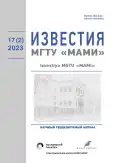Topological optimization of the load-bearing structure of the safety cage
- Authors: Zhitelev D.A.1, Pozdnyakov T.D.1, Sulegin D.A.1
-
Affiliations:
- Bauman Moscow State Technical University
- Issue: Vol 17, No 2 (2023)
- Pages: 179-186
- Section: Transport and transport-technological facilities
- URL: https://journals.rcsi.science/2074-0530/article/view/253974
- DOI: https://doi.org/10.17816/2074-0530-260838
- ID: 253974
Cite item
Full Text
Abstract
BACKGROUND: The conducted study of the stress-strain state of the safety cage developed in compliance with the requirements of the Russian Automotive Federation (RAF) showed that the structure does not meet the requirements of deformation after side impact. Therefore, the basic design demands additional study with the use of state-of-the-art approaches of development.
AIMS: This paper considers the issue of finding the optimal design of a racing car safety cage based on topological optimization in order to meet the rigidity requirements while minimizing the mass.
METHODS: To implement the topological optimization method, mathematical modeling was carried out using the Structural Optimization module of the Ansys software package. Tests regulated by the RAF were selected to test the effectiveness of the optimized design. To evaluate the results, a comparison of the results of test simulation before and after optimization was made.
RESULTS: The mass of the optimized design has decreased by 6% relative to the original. Rigidity of the structure with loading at main and front rollbars remained the same. Deformation of the optimized design with side loading of the main rollbar was reduced by 98%.
CONCLUSIONS: The results of modeling the tests regulated by the RAF showed that the design of the safety cage, developed on the basis of the material pseudo-density map obtained as a result of topological optimization, meets the requirements for permissible deformation. Further study of the stress-strain state of the safety cage should be carried out in conjunction with the finite element model of the vehicle to take into account the loads arising as a result of body deformation.
Full Text
##article.viewOnOriginalSite##About the authors
Daniil A. Zhitelev
Bauman Moscow State Technical University
Author for correspondence.
Email: daniil2699@mail.ru
ORCID iD: 0000-0002-8080-1419
SPIN-code: 6751-6872
Student of the Multipurpose Tracked Vehicles and Mobile Robots Department
Russian Federation, 5, 1 2nd Baumanskaya street, 105005 MoscowTihon D. Pozdnyakov
Bauman Moscow State Technical University
Email: t.pozdnyakov@bmstu.ru
ORCID iD: 0000-0001-8966-1806
SPIN-code: 9150-2654
Senior Lecturer of the Multipurpose Tracked Vehicles and Mobile Robots Department
Russian Federation, 5, 1 2nd Baumanskaya street, 105005 MoscowDmitrii A. Sulegin
Bauman Moscow State Technical University
Email: d_sulegin@bmstu.ru
ORCID iD: 0000-0003-3359-3829
SPIN-code: 6960-2909
Associate Professor, Cand. Sci. (Tech.), First Vice Dean of the Mechanical Engineering Faculty
Russian Federation, 5, 1 2nd Baumanskaya street, 105005 MoscowReferences
- Russian Automobile Federation. Safety equipment: appendix J. Moscow: RAF. 2014:253. (in Russ).
- Zhitelev DA, Pozdnyakov TD, Sulegin DA, et al. Investigation of the experimental and numerical behavior of thin-walled pipes under quasi-static loading conditions. Trudy NGTU im. R.E. Alekseeva. 2022;4(139):85-96. (in Russ). EDN: TVZSXR doi: 10.46960/1816-210X_2022_4_85
- Sulegin DA, Zuzov VN. Topological optimization of the roof structure of a passenger car in order to increase energy intensity in a side impact. Izvestiya MGTU MAMI. 2021;15(1):81-88. doi: 10.31992/2074-0530-2021-47-1-81-88 (in Russ). EDN: UFBAPZ doi:
- 31992/2074-0530-2021-47-1-81-88
- Goncharov RB, Zuzov VN. Features of the search for optimal parameters of the amplifiers of the rear part of the cab of a truck based on parametric and topological optimization in order to ensure the requirements for passive safety according to international rules and obtain its minimum mass. Trudy NGTU im. R.E. Alekseeva. 2019;2(125):163-170. (in Russ). EDN ZTSJEL doi:
- 46960/1816-210X_2019_2_163
- Goncharov RB, Zuzov VN. Topological optimization of the automobile bumper design under impact from the passive safety standpoint. Izvestiya MGTU MAMI. 2018;12(2):2-9. (in Russ). EDN XUWXVB doi: 10.17816/2074-0530-66811
- Shaban BA, Zuzov VN. Features of modeling frame elements of car bodies and cabins in the study of passive safety. Nauka i obrazovanie. Elektron. zhurn. 2012;11:81–104. (in Russ). doi: 10.7463/1112.0486675
- Shaban BA, Zuzov VN. Analysis of the impact of cab design factors on the passive safety of trucks in case of impact on the front pillars. Nauka i obrazovanie. Elektron. zhurn. 2013. № 11. C. 95–106. (in Russ). doi: 10.7463/1113.0636798
- Shaban BA, Zuzov VN. Analysis of the Influence of Design Factors on the Passive Safety of a Truck Cabin in a Frontal Impact. Nauka i obrazovanie. Elektron. zhurn. 2013;8:91–108. (in Russ). doi: 10.7463/0813.0580257
- Goncharov RB, Zuzov VN. Problems of finding optimal design parameters of a car bumper under impact from the standpoint of passive safety. Trudy NGTU im. R.E. Alekseeva. 2018;3(122):130–136. (in Russ).
- Goncharov RB, Zuzov VN. Problems of finding the best solutions to ensure the passive safety of the cabins of trucks at a minimum weight. Izvestiya MGTU MAMI. 2018;12(4):92-102. (in Russ). doi: 10.17816/2074-0530-66869.
- Zuzov VN, Sulegin DA. Study of the impact on the energy intensity of the main power elements of the car body in the side impact zone. Vestnik Yuzhno-Uralskogo gosudarstvennogo universiteta. Seriya: Mashinostroenie. 2020;20(4):20-34. (in Russ). EDN MJDFIQ doi:
- 14529/engin200403
- Sulegin DA, Zuzov VN. Study of the effect of reinforcing elements of a car door on passive safety in a side impact. Trudy NGTU im. R.E. Alekseeva. 2021;1(132):86-97. (in Russ). EDN MPXGAF doi: 10.46960/1816-210X_2021_1_86
- Shaban BA, Zuzov VN. Features of building finite element models of cabins for the study of passive safety on impact in accordance with UNECE rules No. 29. Nauka i obrazovanie. Elektron. zhurn. 2013. № 3. С. 129–156. (in Russ). doi: 10.7463/0313.0542301.
Supplementary files

















